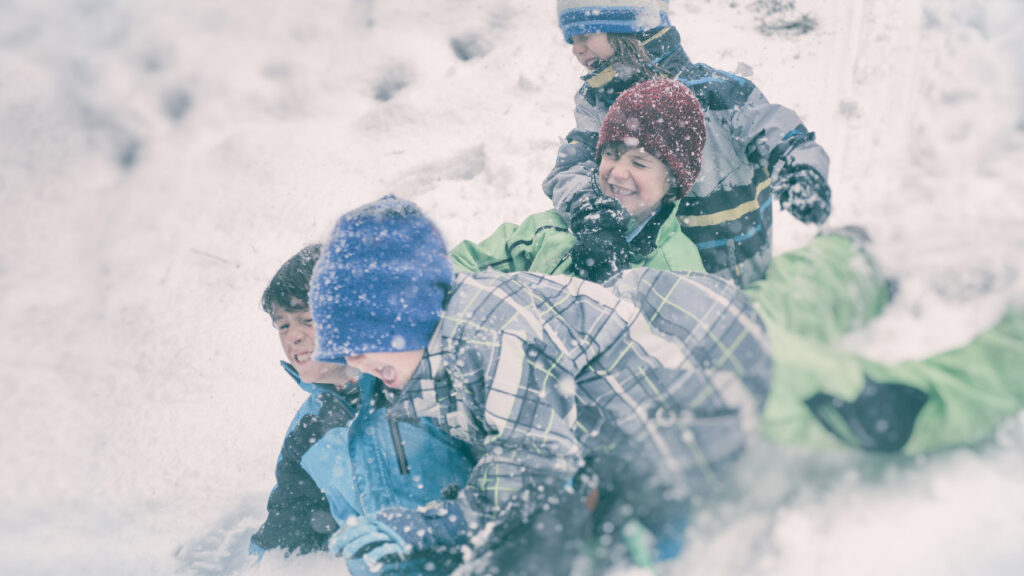 In the emergency department (ED) at Children’s Hospital Colorado, winter is the busiest time of year. “We do our best to accommodate the volume,” says Mike DiStefano, MD, a pediatric emergency medicine specialist at Children’s Colorado.
In the emergency department (ED) at Children’s Hospital Colorado, winter is the busiest time of year. “We do our best to accommodate the volume,” says Mike DiStefano, MD, a pediatric emergency medicine specialist at Children’s Colorado.
But emergency rooms, Dr. DiStefano explains, care for the most acute patients first — meaning high volumes can lead to long wait times for less emergent cases. The good news is that many times those less urgent cases don’t need to be in the ED in the first place.
Below, Dr. DiStefano outlines the biggest winter reasons kids end up in the ED in Denver — and what parents can do to avoid it.
The cause: COVID-19
Children are less likely to develop severe COVID-19 due to infection with the coronavirus. In fact, many children may have mild cold-like symptoms or no symptoms at all. Some children may need a trip to the emergency room or hospital care, but the good news is, we can now prevent severe COVID-19 for most age groups.
The fix: vaccination and layers of protection
The COVID-19 vaccine is highly effective at preventing severe COVID-19 disease in children and is safe and effective for ages 6 months and older. COVID-19 can look similar to the flu and other respiratory viruses, so it is very important that children with cold-like symptoms — fever, cough, congestion or sore throat — get tested for COVID-19 to determine whether quarantining is necessary. Testing may also be a requirement for returning to school or daycare.
Remember that even though children are less likely to become severely ill from COVID-19, they can get sick and spread the virus, so it is important to take COVID-19 seriously and stay up to date on the latest public health guidance during the pandemic.
If you suspect your child has COVID-19, testing can easily be done with the over-the-counter home tests. Area testing sites have closed due to lower demand for these types of services. If there is any uncertainty, or a test that is unclear, Partner’s in Pediatrics can perform a PCR test for accuracy.
The cause: influenza
Influenza, commonly called “the flu,” is unpleasant enough as it is, but one potentially dangerous consequence of it for kids and adults alike is that all those, uh, expelled fluids can result in dehydration. Dr. DiStefano frequently sees kids requiring intravenous (IV) rehydration.
“When kids throw up, parents give them a bottle of Powerade or Pedialyte,” says Dr. DiStefano. “And kids are thirsty, so they chug it, and that doesn’t go that well if the intestines aren’t functioning.”
The fix: slow rehydration
Instead of a bunch of fluids all at once, begin very slowly by giving 1/2 to 1 ounce of liquid every 20 minutes for 1 to 2 hours while your child is awake. If this small amount is held down, advance to 1 to 2 ounces of clear liquids every 30 to 60 minutes for several more hours. Do not continue clear liquids only, without solids, for longer than 24 hours without calling your health-care provider. Infants may tolerate only 1 teaspoonful of liquid at first, but you can gradually build volume to 1 to 2 ounces.
If an infant or child vomits at any point in this slow advance of fluids, give him another rest period of 30 to 60 minutes and try again at the point where you left off, or you may try offering 1 to 2 teaspoons every 5 to 10 minutes, gradually increasing the volume.
Do not give cold liquids. Room-temperature fluids are always better tolerated.
Your child may want larger amounts of liquid or even desire solids. Resist the temptation to give larger volumes of fluid or solids until he has gone
4 to 6 hours without vomiting,
For more in-depth solutions for rehydration, see the chapter “Vomiting” in the Naturally Healthy Kids Handbook from Partners in Pediatrics.
The cause: respiratory syncytial virus
This common virus, commonly shortened to RSV, produces cold-like symptoms in older children and adults. For a very small minority of kids 2 and younger, it can also have potentially life-threatening effects.
“It essentially causes mucus production and plugging in the lungs,” says Dr. DiStefano. “The smaller the air tubes, the bigger the problem.” In very rare cases, the condition in babies can be severe enough to require a ventilator.
The fix: bringing the fever down
“Sometimes when kids get high fevers, the respiratory system gets taxed,” says Dr. DiStefano. “Getting the fever down can help.” Try a warm washcloth to allow for evaporation, a fan, cool foods like popsicles and acetaminophen. Be sure to give your child the correct dose for their age and weight. Nasal suctioning, as well as a nasal saline solution, can also be helpful.
What won’t help: over-the-counter cough and cold remedies, as well as products that claim to “break up mucus.” They’re neither particularly effective nor good for babies.
If your child seems to be having trouble breathing, call 911 right away.
The cause: winter activity accidents
“When we get a big dump of snow, the number of sledding injuries and fractures go up,” says Dr. DiStefano. “I had one day where two separate kids decided to sled off the roof. Both broke bones.”
Lots can happen in the snow. Sledding, skiing and snowboarding can lead to concussions, fractures and sprains. Even heading outside without the right clothing can result in exposure injuries.
The fix: safety, preparation and supervision
Sledding and snow tubing
Sledding injuries can result from collisions with trees, equipment and debris, but just as many result from one person plowing into another. Here are a few tips for finding a safe place:
- Find a good hill. Choose one that has a clear path without obstacles in the way. Make sure that the hill does not end on a street, road, parking lot, fence or any bodies of water such as a pond or river. Choose a low-traffic hill (no roofs, please) wherever possible.
- Never slide downhill headfirst. Sit up facing forward to steer. Risks of head and back injuries are greater by lying down on the sled.
- Clear the bottom of the hill. Make sure that no one is at the bottom of the hill before allowing another sled to go down the slope.
- Do not use materials that can be pierced by objects in the ground as a sled. Examples include rubber or plastic sheets.
- Use a sled with runners and a steering mechanism. Toboggans and snow disks are not as safe.
Snowmobiling
- Any child under 6 years of age should not be allowed to ride on a snowmobile, regardless of whether an adult is present.
- Children under 16 years of age should not be permitted to operate the snowmobile.
- A bike helmet is not appropriate. Do wear certified helmets designed specifically for high-speed motor sports.
Ice skating
Choose skating rinks over pond skating.
If you do choose pond skating, here are some recommendations:
- Call local authorities to ask which areas have been approved and to ask permission to skate on a pond or lake.
- Ice skating on a pond or lake always carries some risk, but you can take some precautions to be safe. For example, Colorado Parks and Wildlife suggests checking online or calling local officials for guidance on a particular area’s safety.
- Sharpen those skates properly before skating on pond or lake ice.
Skiing and snowboarding
- If your child has never skied or snowboarded, enroll them in lessons.
- Warm up the muscles that will be used in skiing and snowboarding with exercise activities to help prevent injuries. Take the time to stretch after the warmup as well.
- Use proper ski and snowboard equipment such as well-fitted boots and adjusted bindings. Ask a certified technician to help with the fittings.
- Stick to trails and runs appropriate for your child’s skill level.
- Pay attention to signs on the trail. Obey trail closure and do not go off trail.
- Always wear a certified helmet for skiing and snowboarding.
- If you’re heading to the backcountry, dress kids very warmly and check the weather to make sure you will be able to get back safely. Frostbite is real, and it can happen fast.
- Before heading out, check the avalanche forecast for your destination. If the danger is high, stay home or choose a safer area.
General safety for any winter activity
- Always wear a helmet and make sure they are properly fitted and secured under the chin.
- Helmet safety is of utmost importance to help prevent head injuries.
- Different activities require different types of helmets so choose appropriately and make sure they are certified to meet federal safety standards.
- An adult should always be present to supervise.
- Dress for the winter – wear warm fitting clothes, dress in layers and stay dry.
- Stay hydrated. Have them drink fluid before, during and after their activities.
- Don’t forget sunscreen! Even on overcast days, especially up in the mountains, the sun rays can be harmful.
Still, accidents do happen, and when they do, it’s a good idea to take advantage of urgent care instead of the ED whenever appropriate. For example, if your child is experiencing a head injury with confusion, lethargy or vomiting, or if they have injured an extremity like an arm or leg with severe swelling or deformity, you can seek help at urgent care. Children’s Colorado’s urgent care clinics treat many of the same conditions and injuries as the ED, and the wait times are a lot shorter.
At Partners in Pediatrics, we are holistic pediatricians committed to educating our Denver community with integrative and functional wellness / health care topics to help you and your kids maintain optimal health. No pediatric care plan would be complete without winter health and safety tips for the mile-high city.
As always, please get in touch with us with any questions about winter safety, injuries, or injury prevention. If you’re interested in more comprehensive advice for assessing injuries, please contact us and speak with our team serving patients in Denver, Littleton, Cherry Creek, and the surrounding areas of Colorado.
Thank you to Children’s Hospital of Colorado for this comprehensive guide to winter safety!



Leave a Reply